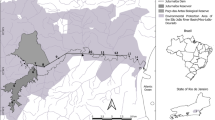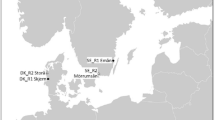Abstract
Native fishes worldwide have declined as a consequence of habitat loss and degradation and introduction of non-native species. In response to these declines, river restoration projects have been initiated to enhance habitat and remove introduced fishes; however, non-native fish removal is not always logistically feasible or socially acceptable. Consequently, managers often seek to enhance degraded habitat in such a way that native fishes can coexist with introduced species. We quantified dynamics of fish communities to three newly constructed side channels in the Provo River, Utah, USA, to determine if and how they promoted coexistence between native fishes (nine species) and non-native brown trout (Salmo trutta L.). Native and introduced fishes responded differently in each side channel as a function of the unique characteristics and histories of side channels. Beaver activity in two of the three side channels caused habitat differentiation or channel isolation that facilitated the establishment of native species. The third side channel had greater connectivity to and similar habitat as the main channel of the Provo River, resulting in a similar fish community to main channel habitats (i.e. dominated by brown trout with only a few native fish species). These results demonstrate the importance of understanding habitat preferences for each species in a community to guide habitat enhancement projects and the need to create refuge habitats for native fishes.




Similar content being viewed by others
References
Allan JD, Flecker AS (1993) Biodiversity conservation in running waters. Bioscience 43:32–43
Avenetti LD, Robinson AT, Cantrell CJ (2006) Short-term effectivenss of constructed barriers at protecting Apache trout. N Am J Fish Manag 26:213–216
Bernhardt ES, Palmer MA, Allan JD, Alexander G, Barnas K, Brooks S, Carr J, Clayton S, Dahm C, Follstad-Shah J, Galat D, Gloss S, Goodwin P, Hart D, Hassett B, Jenkinson R, Katz S, Kondolf GM, Lake PS, Lave R, Meyer JL, O’Donnell TK, Pagano L, Powell B, Sudduth E (2005) Synthesizing U.S. river restoration efforts. Science 308:636–637
Billman EJ, Tjarks BJ, Belk MC (2011) Effect of predation and habitat quality on growth and reproduction of a stream fish. Ecol Freshw Fish 20:102–113
Bray JR, Curtis JT (1957) An ordination of the upland forest communities of southern Wisconsin. Ecol Monogr 27:326–349
Bruton MN (1995) Have fishes had their chips? The dilemma of threatened fishes. Environ Biol Fish 43:1–27
Clarke KR, Gorley RN (2006) Primer v6: User manual/tutorial. Primer-E, Plymouth
Danehy RJ, Ringler NH, Stehman SV, Hassett JM (1998) Variability of fish densities in a small catchment. Ecol Freshw Fish 7:36–48
de la Hoz Franco EA, Budy P (2005) Effects of biotic and abiotic factors on the distribution of trout and salmon along a longitudinal stream gradient. Environ Biol Fish 72:379–391
Ellsworth CM (2003) Response of the fish community and age class structure to channelization and habitat restoration in the Provo River between Deer Creek and Jordanelle Reservoirs. M.S. thesis, Department of Integrative Biology, Brigham Young University, Provo, UT
Fraser DF, Gilliam JF (1992) Nonlethal impacts of predator invasion: facultative suppression of growth and reproduction. Ecology 73:959–970
Frissell CA (1993) Topology of extinction and endangerment of native fishes in the Pacific Northwest and California (USA). Conserv Biol 7:342–354
Habit E, Piedra P, Ruzzante DE, Walde SJ, Belk MC, Cussac VE, Gonzalez J, Colin N (2010) Changes in the distribution of native fishes in response to introduced species and other anthropogenic effects. Global Ecol Biogeogr 19:697–710
Hasegawa K, Maekawa K (2008) Different longitudinal distribution patterns of native white-spotted charr and non-native brown trout in Monbetsu stream, Hokkaido, northern Japan. Ecol Freshw Fish 17:189–192
Hasegawa K, Yamamoto T, Kitanishi S (2010) Habitat niche separation of the nonnative rainbow trout and native masu salmon in the Atsuta River, Hokkaido, Japan. Fish Sci 76:251–256
Hilderbrand RH, Kershner JL (2000) Conserving inland cutthroat trout in small streams: how much stream is enough? N Am J Fish Manag 20:513–520
Hilderbrand RH, Watts AC, Randle AM (2005) The myths of restoration ecology. Ecol Soc 10:19
Huffaker CB (1958) Experimental studies on predation: dispersion factors and predator-prey oscillations. Hilgardia 27:795–835
Korsu K, Huusko A, Korhonen PK, Yrjänä T (2010a) The potential role of stream habitat restoration in facilitating salmonid invasions: a habitat-hydraulic modeling approach. Restor Ecol 18:158–165
Korsu K, Huusko A, Muotka T (2010b) Invasion of northern European streams by brook trout: hostile takeover or pre-adapted habitat niche segregation? Biol Invasions 12:1363–1375
Li HW, Li JL (2006) Role of fish assemblages in stream communities. In: Hauer FR, Lamberti GA (eds) Methods in stream ecology, 2nd edn. Elsevier, Inc, San Diego
Lodge DM (1993) Biological invasions: lessons from ecology. Trends Ecol Evol 8:133–137
Magurran AE (1988) Ecological diversity and its measurement. Chapman and Hall, London
McHugh P, Budy P (2005) An experimental evaluation of competitive and thermal effects on brown trout (Salmo trutta) and Bonneville cutthroat trout (Oncorhynchus clarkii utah) performance along an altitudinal gradient. Can J Fish Aquat Sci 62:2784–2795
McHugh P, Budy P (2006) Experimental effects of nonnative brown trout on the individual- and population-level performance of native Bonneville cutthroat trout. T Am Fish Soc 135:1441–1455
Mills MD, Rader RB, Belk MC (2004) Complex interactions between native and invasive fish: the simultaneous effects of multiple negative interactions. Oecologia 141:713–721
Minkley WL, Deacon JE (1991) Battle against extinction: Native fish management in the American West. University of Arizona Press, Tuscon
Nakano S, Fausch KD, Kitano S (1999) Flexible niche partitioning via a foraging mode shift: a proposed mechanism for coexistence in stream-dwelling charrs. J Anim Ecol 68:1079–1092
Nannini MA, Belk MC (2006) Antipredator responses of two native stream fishes to an introduced predator: does similarity in morphology predict similarity in behavioural response? Ecol Freshw Fish 15:453–463
Naslund I, Degerman E, Nordwall F (1998) Brown trout (Salmo trutta) habitat use and life history in Swedish streams: possible effects of biotic interactions. Can J Fish Aquat Sci 55:1034–1042
National Research Council, Committee on Restoration of Aquatic Ecosystems (1992) Restoration of aquatic ecosystems. National Academy Press, Washington, D.C
O’Neal JS (2007) Snorkel surveys. In: Johnson DH, Shrier BM, O’Neal JS, Knutzen JA, Augerot X, O’Neil TA, Pearsons TN (eds) Salmonid field protocols handbook: Techniques for assessing status and trends in salmon and trout populations. American Fisheries Society, Bethesda, pp 325–340
Olsen DG, Belk MC (2005) Relationship of diurnal habitat use of native stream fishes of the eastern Great Basin to presence of introduced salmonids. West N Am Naturalist 65:501–506
Ogutu-Ohwayo R (1993) The effects of predation by Nile perch, Lates niloticus L., on the fish of Lake Nabugabo, with suggestions for conservation of endangered endemic cichlids. Conserv Biol 7:701–711
Palmer MA, Bernhardt ES, Allan JD, Lake PS, Alexander G, Brooks S, Carr J, Clayton S, Dahm CN, Follstad Shah J, Galat DL, Loss SG, Goodwin P, Hart DD, Hassett B, Jenkinson R, Kondolf GM, Lave R, Meyer JL, O’Donnell TK, Pagano L, Sudduth E (2005) Standards for ecologically successful river restoration. J Appl Ecol 42:218–217
Palmer MA, Menninger HL, Bernhardt E (2010) River restoration, habitat heterogeneity, and biodiversity: a failure of theory or practice? Freshw Biol 55:205–222
Petersen RC, Madsen BL, Wilzbach MA, Magadza CHD, Paarlberg A, Kullberg A, Cummins KW (1987) Stream management: emerging global similarities. Ambio 16:166–179
Power ME (1984) Depth distributions of armored catfish: predator-induced resource avoidance? Ecology 65:523–528
Rahel FJ (2000) Homogenization of fish faunas across the United States. Science 288:854–856
Rahel FJ (2002) Homogenization of freshwater faunas. Annu Rev Ecol Syst 33:291–315
Rahel FJ (2007) Biogeographic barriers, connectivity, and homogenization of freshwater faunas; it’s a small world after all. Freshw Biol 52:696–710
Rosenberger A, Angermeier PL (2003) Ontogenetic shifts in habitat use by the endangered Roanoke logperch (Percina rex). Freshw Biol 48:1563–1577
Schiemer F (2000) Fish as indicators for the assessment of the ecological integrity of large rivers. Hydrobiologia 422(423):271–278
Schlosser IJ (1987) The role of predation in age- and size-related habitat use by stream fishes. Ecology 68:651–659
Schlosser IJ, Kallemeyn LW (2000) Spatial variation in fish assemblages across a beaver-influenced successional landscape. Ecology 81:1371–1382
Shiozawa DK, Rader RB (2005) Great Basin Rivers. In: Benke AC, Cushing CE (eds) Rivers of North America. Elsevier Academic Press, San Diego, pp 655–694
Sigler WF, Miller RR (1963) Fishes of Utah. Utah State Department of Fish and Game, Salt Lake City
Snodgrass JW, Meffe GK (1998) Influence of beavers on stream fish assemblages: effects of pond age and watershed position. Ecology 79:928–942
Thurow RF, Peterson JT, Guzevich JW (2006) Utility and validation of day and night snorkel counts for estimating bull trout abundance in first- and third-order streams. N Am J Fish Manag 26:217–232
Townsend CR (1996) Invasion biology and ecological impacts of brown trout, Salmo trutta, in New Zealand. Biol Conserv 78:13–22
Townsend CR (2003) Individual, population, community, and ecosystem consequences of a fish invader in New Zealand streams. Conserv Biol 17:38–47
Walser CA, Belk MC, Shiozawa DK (1999) Habitat use of leatherside chub (Gila copei) in the presence of predatory brown trout (Salmo trutta). Great Basin Nat 59:272–277
Werner EE, Gilliam JF (1984) The ontogenetic niche and species interactions in size-structured populations. Annu Rev Ecol Syst 15:393–425
Wilson KW, Belk MC (2001) Habitat characteristics of leatherside chub (Gila copei) at two spatial scales. West N Am Naturalist 61:36–42
Zedler JB (2000) Progress in wetland restoration ecology. Trends Ecol Evol 15:402–407
Acknowledgments
Funding was provided by the Utah Mitigation Restoration and Conservation Commission, the Utah Division of Wildlife Resources (UDWR), and the Departments of Biology and Plant and Wildlife Sciences at Brigham Young University. Data for main channel surveys were provided by UDWR. Activities were conducted under permits obtained from the UDWR. Craig Ellsworth and Sage Kelley provided assistance during snorkeling surveys.
Author information
Authors and Affiliations
Corresponding author
Electronic supplementary material
Below is the link to the electronic supplementary material.
ESM 1
(DOC 40 kb)
Rights and permissions
About this article
Cite this article
Billman, E.J., Kreitzer, J.D., Creighton, J.C. et al. Habitat enhancement and native fish conservation: can enhancement of channel complexity promote the coexistence of native and introduced fishes?. Environ Biol Fish 96, 555–566 (2013). https://doi.org/10.1007/s10641-012-0041-2
Received:
Accepted:
Published:
Issue Date:
DOI: https://doi.org/10.1007/s10641-012-0041-2




